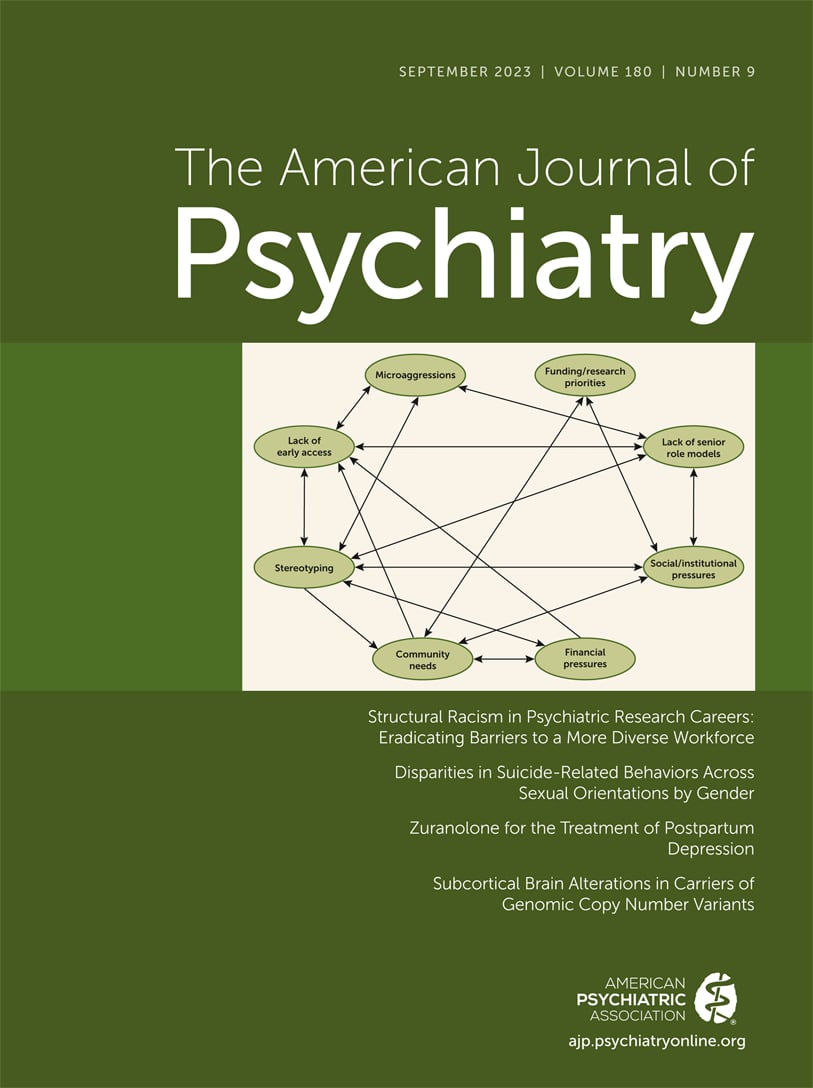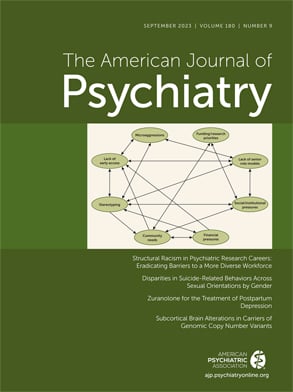In this issue, Chum and colleagues (
1) use linked community survey and health records data to examine differences in risk of self-harm and suicidal behavior across sexual orientation. They report that risk of any self-harm or suicidal behavior was approximately three times as high among people who identified as bisexual and approximately two times as high among people who identified as gay or lesbian, both compared to people who identified as heterosexual. To put this new research in context, we should consider what was previously known regarding this question, what new knowledge or clarity this study adds, what actions these results should motivate, and what important questions should still be addressed. As Chum and colleagues did, this editorial will use the terms gay, lesbian, bisexual, and heterosexual—acknowledging both that those categories do not encompass the diversity of human sexual orientation and that boundaries between those categories are neither fixed nor distinct.
What Was Known
Previous research certainly suggested increased risk of self-harm or suicidal behavior among people identifying as lesbian, gay, and bisexual, but methodologic limitations left significant uncertainty. Studies limited to health records data could accurately ascertain self-harm events that led to health care contact, but those studies could only identify sexual orientation recorded in medical records. Incomplete or biased identification of sexual orientation in health records (
2) could either obscure or magnify true differences between groups. Studies limited to community surveys could systematically assess self-identified sexual orientation, but ascertainment of self-harm events from surveys would be subject to errors of recall and social desirability bias. Poor recall of self-harm could obscure true differences, and shared social desirability biases (e.g., if respondents less likely to report lesbian, gay, or bisexual orientation were also less likely to report suicidal behavior) could falsely magnify differences.
What Was Learned
Chum and colleagues linked survey data from a systematic sample of the Ontario population with comprehensive health records and vital statistics data, avoiding some limitations of previous research. Their findings confirm a higher risk of self-harm or suicidal behavior among lesbian, gay, and bisexual adults; document that the increased risk is not accounted for by differences in race, educational attainment, rurality, or marital status; and find that higher risk among people identifying as bisexual concentrated among those also identifying as female. As the authors acknowledge, health records and vital statistics data would not capture self-harm or suicidal behavior that either did not lead to health care contact or was not identified as self-harm. While these analyses considered both nonfatal and fatal self-harm, the number of fatal self-harm events was not large enough to specifically examine risk of suicide death.
The data available to Chum and colleagues cannot directly address how or why sexual orientation is related to suicidal ideation and behavior. Following minority stress theory (
3), the authors propose that increased risk of suicidal ideation and behavior among people identifying as lesbian, gay, or bisexual results not from sexual orientation but from a hostile environment. Previous research supports that view. For example, gay men who moved within Europe from higher-bias to lower-bias environments reported reductions in depression and suicidal ideation (
4). Among U.S. adolescents, suicidal ideation and behavior were related not directly to sexual orientation but instead to experiences of harassment regarding sexual orientation (
5).
What Should Be Done
As Chum and colleagues point out, the increased risk of suicidal behavior in people identifying as lesbian, gay, and bisexual has practical implications for general medical and mental health care delivery. At the level of health systems and health care facilities, more welcoming environments will reduce stigma and facilitate discussion of both sexual orientation and the experience of suicidal ideation. Individual clinicians should be especially attentive to the unmet mental health needs of people identifying as lesbian, gay, or bisexual—as they would for any other group of people known to be at increased risk of suicidal ideation and behavior.
The additional knowledge that increased risk results from experiences of discrimination and harassment has additional specific implications. Mental health clinicians should consider those experiences of discrimination and harassment as added contributions to risk of self-harm. And clinicians should consider how clinical interventions can address those specific risk factors.
The finding of increased risk among people who identify as lesbian, gay, or bisexual should certainly not be used to reinforce homophobic attitudes or resurrect discredited beliefs that lesbian or gay sexual orientations are mentally disordered. Given evidence for the adverse consequences of discrimination or harassment, misguided attempts to treat or convert sexual orientation cannot be considered safe or accepted medical practice.
What We Still Need to Know
As Chum and colleagues point out, the data available did not consider gender identity or other varieties of sexual orientation. And the survey data available included only respondents age 18 or older. Given the alarming increase in rates of suicidal ideation and behavior among youths, analogous high-quality data regarding youths are needed.
The data available were also not sufficient to examine distinct questions regarding age effects (does the higher risk of suicidal behavior among people identifying as lesbian, gay, or bisexual decrease with age?) and period effects (did that elevated risk decrease between 2003 and 2020?). Those are more than technical epidemiologic questions. Our promise to sexual and gender minority youth is that “It Gets Better.” Observing that the adverse effects of bias and discrimination do get better with time—either within the lives of individuals or in our life as a community—would constitute evidence that we are making good on that promise.

